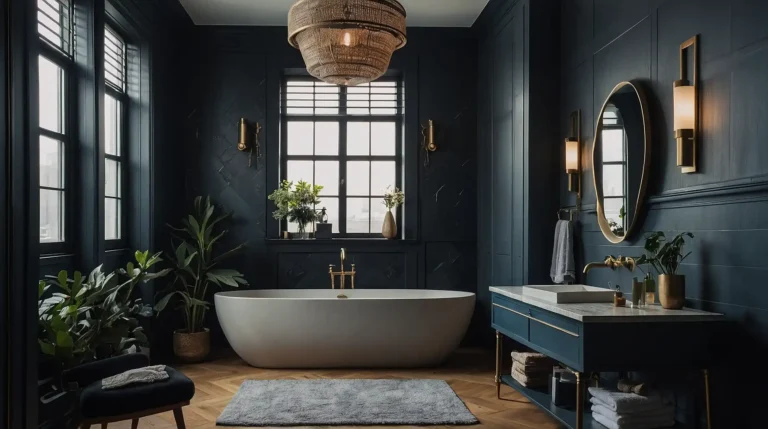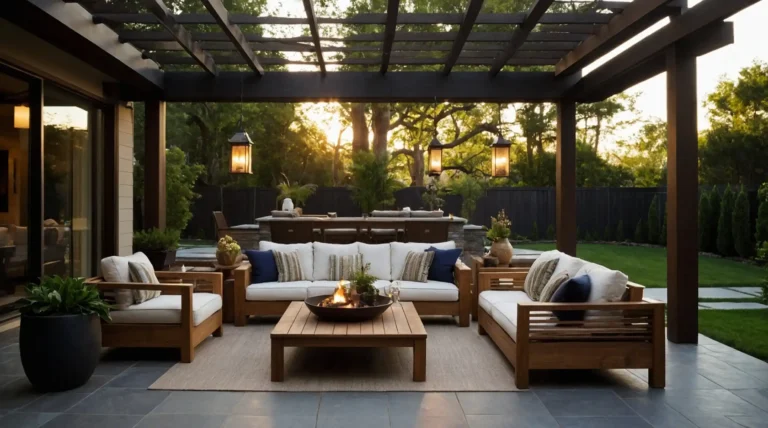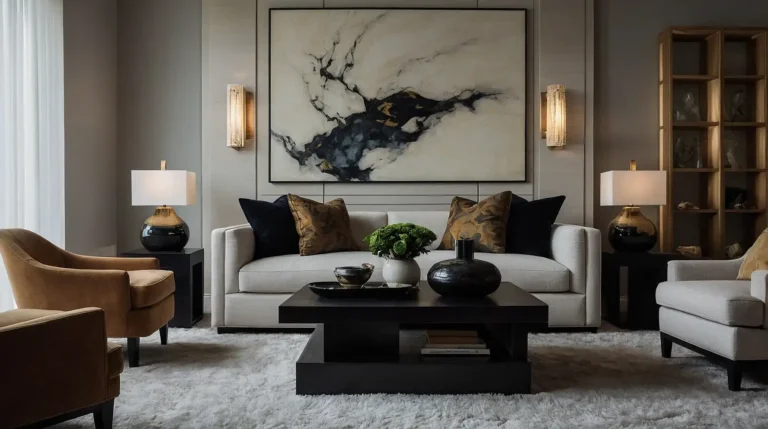27 Best Small & Large Living Room Layout Ideas
Your living room layout determines how comfortable and functional your space feels every single day.
Smart furniture placement transforms any room into an inviting gathering place.
Whether you’re working with a cozy apartment or spacious open-concept home, these proven strategies maximize your potential.
Good layouts improve traffic flow while creating natural conversation areas.
Discover arrangement ideas that make every square foot count while reflecting your personal style beautifully.
1: Corner Conversation Nook Creation
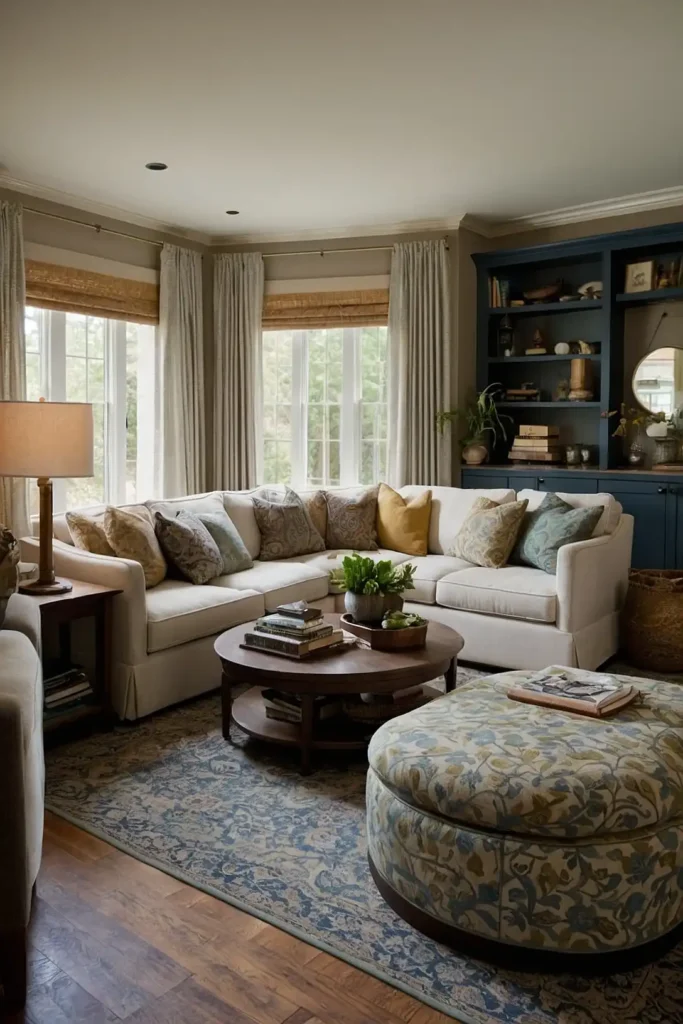
Position two chairs at an angle in your room’s corner to create an intimate seating area.
You’ll establish a cozy retreat that doesn’t dominate the entire space.
Add a small side table between chairs for drinks and books.
This arrangement works perfectly in both small apartments and large rooms needing additional seating.
Choose chairs that complement your main seating without matching exactly.
The corner placement keeps traffic flowing while providing a quiet conversation spot.
2: Floating Furniture Center Arrangement
Pull your sofa away from walls to create breathing room around all sides.
You’ll make small spaces feel larger while improving traffic flow significantly.
Place the sofa in your room’s center with a console table behind it.
This arrangement creates natural pathways while defining separate functional areas.
Add area rugs underneath furniture groupings to anchor the floating pieces visually.
The open space around furniture makes rooms appear more spacious and sophisticated.
3: Multi-Functional Storage Ottoman Focus
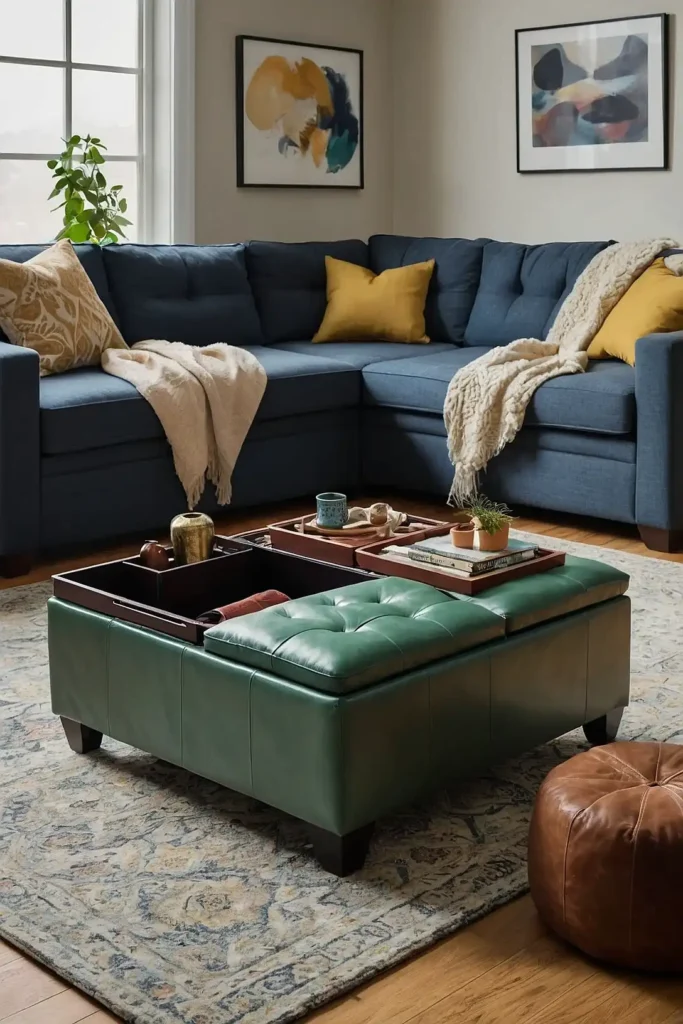
Choose a large storage ottoman that serves as seating, coffee table, and hidden storage simultaneously.
You’ll maximize functionality while minimizing visual clutter throughout your space.
Position the ottoman centrally where it’s accessible from all seating areas.
This versatile piece adapts to different needs while maintaining clean design lines.
Select ottomans with removable tops for easy access to stored items.
The multi-purpose approach works especially well in smaller living rooms with limited storage options.
4: Wall-Mounted Entertainment Center Design

Mount your television and storage components directly on the wall to free up valuable floor space.
You’ll create a streamlined entertainment area that doesn’t overwhelm your room.
Install floating shelves around the TV for decorative items and media storage.
This vertical approach draws the eye upward while keeping surfaces clear.
Choose slim-profile mounts that keep electronics close to the wall surface.
The space-saving design works perfectly in both compact and expansive living room layouts.
5: Sectional Sofa Room Division

Use an L-shaped sectional to naturally separate your living room into distinct functional zones.
You’ll define spaces without installing permanent walls or barriers.
Position the sectional to create a main seating area while leaving open pathways.
This arrangement works especially well in open-concept homes requiring subtle room definition.
Add accent pillows that tie into your overall color scheme throughout the space.
The sectional becomes an architectural element that organizes your entire room layout.
6: Dual-Purpose Window Seat Integration

Install a built-in window seat that provides extra seating while offering hidden storage underneath.
You’ll maximize natural light while creating a charming focal point.
Add cushions and throw pillows that complement your main seating area colors.
This cozy spot becomes perfect for reading while maintaining visual connection to conversations.
Include electrical outlets within the window seat for charging devices conveniently.
The integration approach works beautifully in both traditional and contemporary living room designs.
7: Vertical Storage Wall Solutions
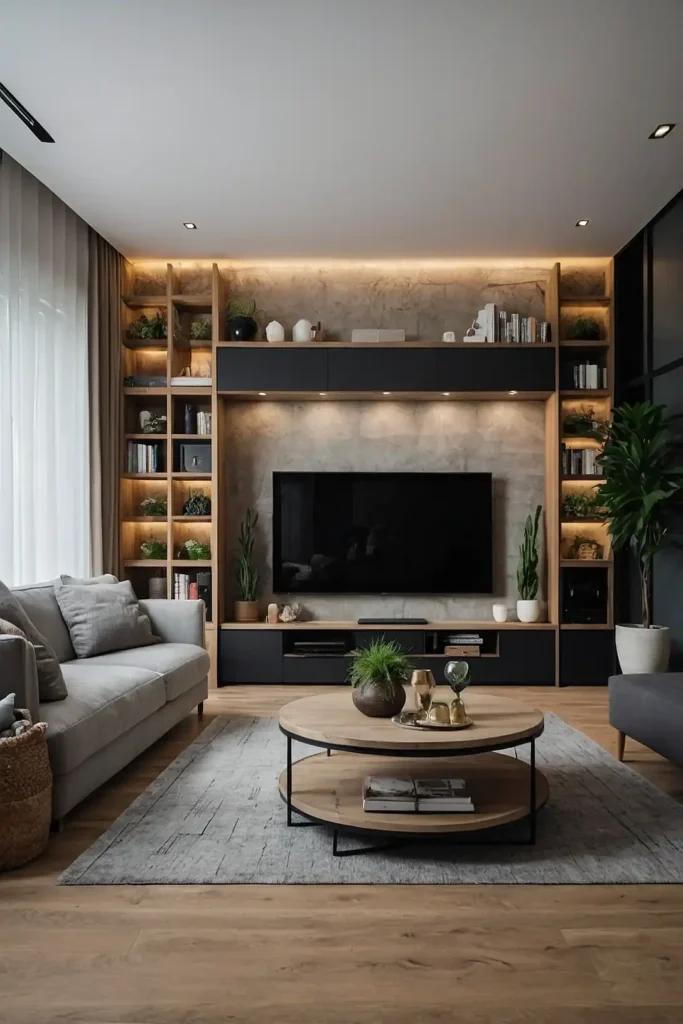
Install floor-to-ceiling shelving that draws attention upward while providing extensive storage throughout your space.
You’ll create the illusion of height in any room size.
Mix open shelving with closed cabinets for displaying treasures while hiding everyday clutter.
This balanced approach maintains visual interest without overwhelming your design scheme.
Choose shelving materials that complement your existing furniture finishes perfectly.
The coordinated approach ensures storage enhances rather than dominates your overall living room aesthetic.
8: Strategic Mirror Wall Expansion
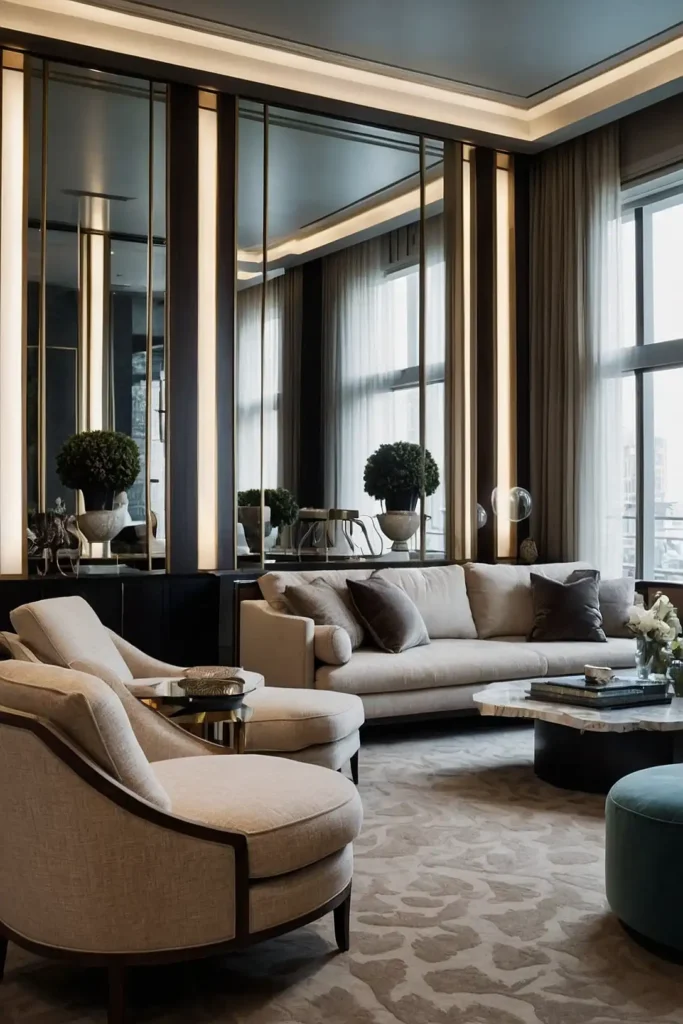
Position large mirrors opposite windows to reflect natural light throughout your living space.
You’ll double the perceived room size while brightening darker areas significantly.
Choose mirrors with decorative frames that complement your furniture style and color palette.
The reflective surfaces create depth while serving as attractive wall art.
Install multiple smaller mirrors in groupings for dramatic impact without overwhelming smaller spaces.
This approach adds visual interest while maintaining the light-enhancing benefits.
9: Light Color Palette Foundation
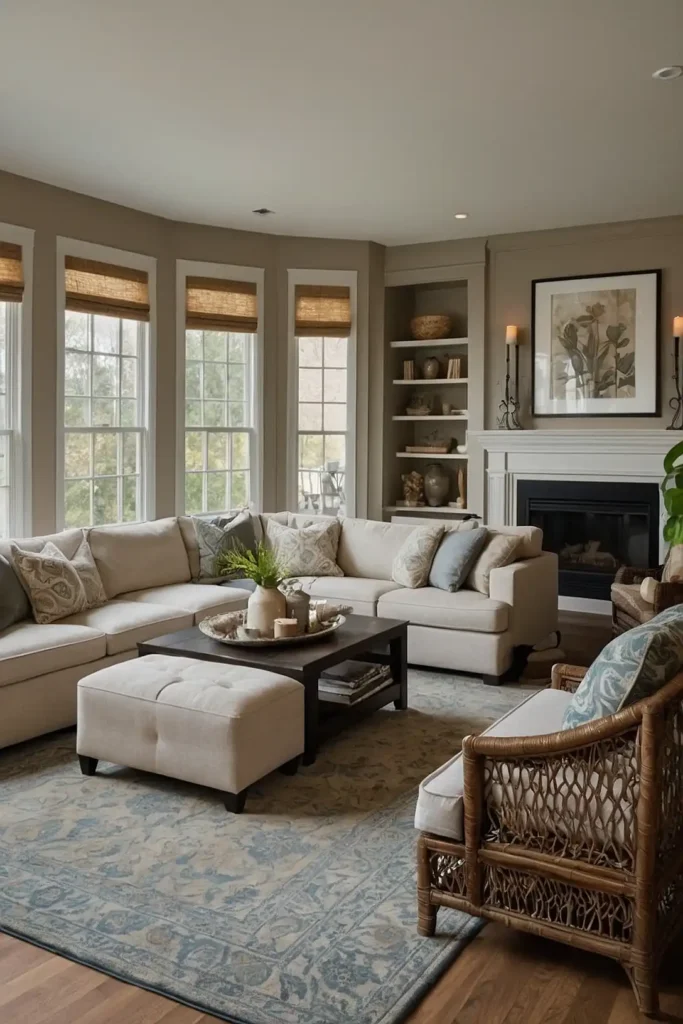
Choose pale colors for walls, large furniture pieces, and window treatments throughout your space.
You’ll create an airy atmosphere that makes any room feel more spacious.
Add darker accent colors through pillows, artwork, and accessories for visual depth.
This layered approach prevents rooms from appearing washed out or sterile.
Paint trim and ceilings in crisp white to maximize light reflection.
The cohesive light palette works especially well in smaller spaces that need visual expansion.
10: Multiple Conversation Area Zones
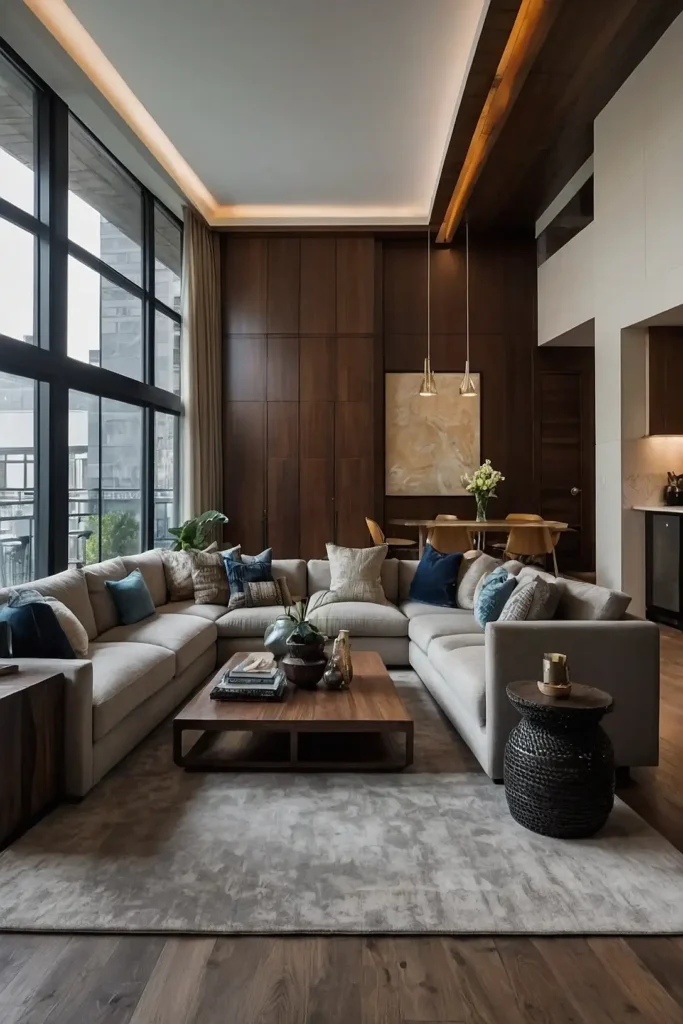
Create several distinct seating groupings throughout large living rooms for intimate conversations.
You’ll accommodate different activities while maintaining overall room unity and flow.
Position furniture clusters around natural focal points like fireplaces or windows.
Each grouping should include seating for 3-4 people comfortably without feeling cramped.
Connect separate areas through consistent color schemes and repeated design elements.
This approach prevents large rooms from feeling empty while encouraging social interaction.
11: Console Table Room Divider
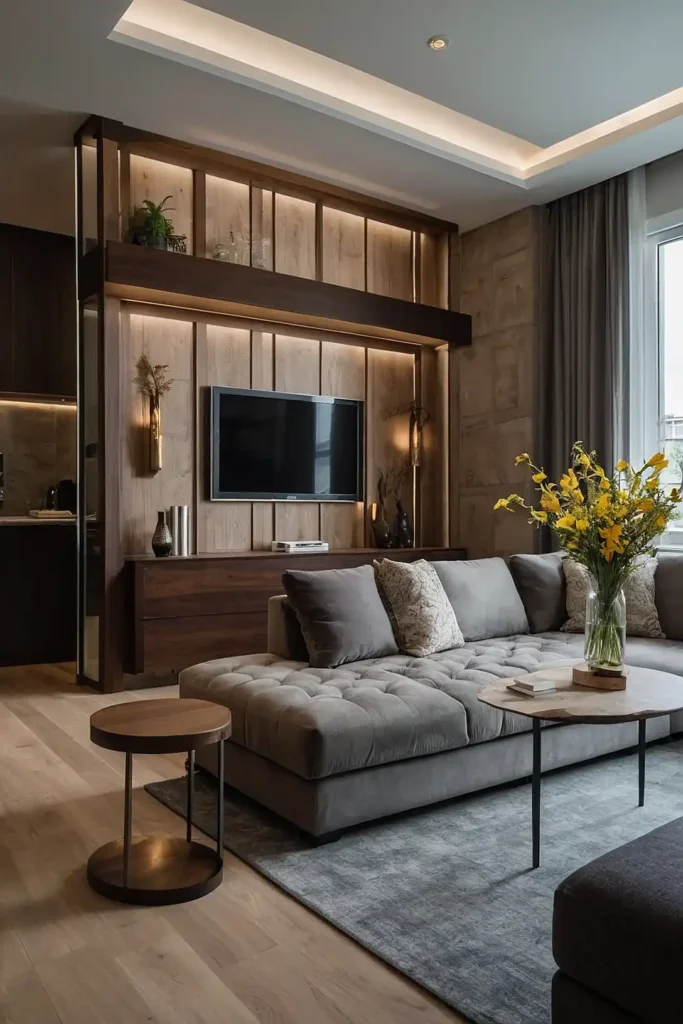
Place a long console table behind your sofa to separate living and dining areas naturally.
You’ll define spaces while maintaining visual connection between functional zones.
Add table lamps and decorative objects to create an attractive display surface.
The console provides storage while serving as an architectural element that organizes your space.
Choose heights that align with your sofa back for proportional balance.
This subtle division technique works perfectly in open-concept homes requiring gentle space definition.
12: Central Fireplace Focal Point
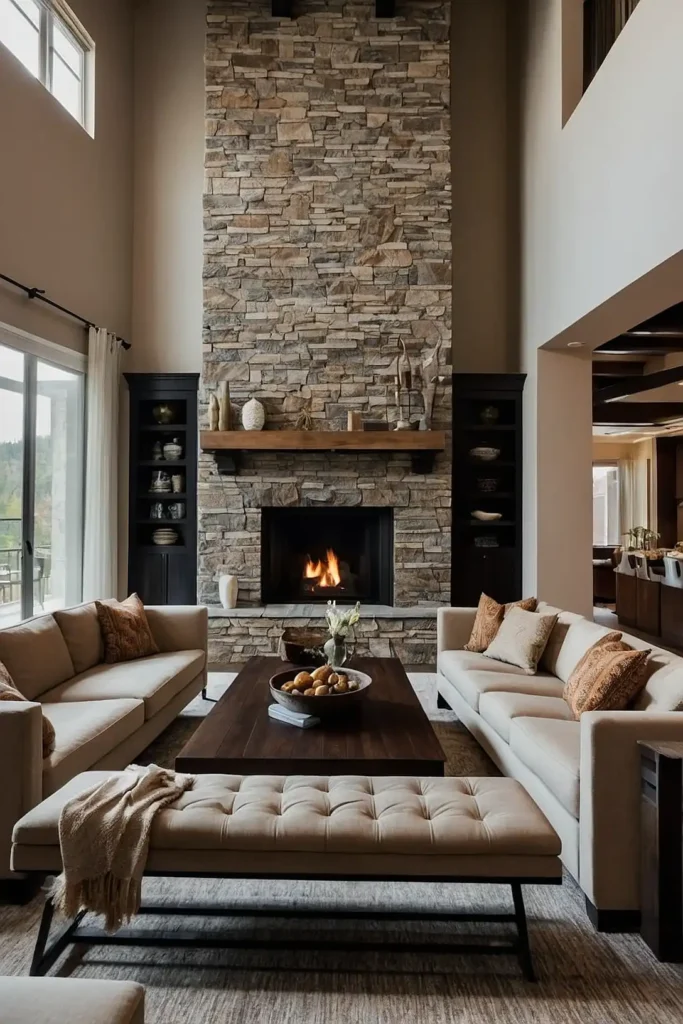
Arrange all seating to face your fireplace while maintaining comfortable conversation distances between pieces.
You’ll create a natural gathering point that anchors your entire room layout.
Add a coffee table within easy reach of all seating for convenience.
This classic arrangement encourages relaxation while providing practical surfaces for drinks and books.
Include side tables near each seating piece for personal items and lighting.
The symmetrical approach creates formal elegance while maintaining everyday functionality throughout your space.
13: Symmetrical Balance Furniture Placement
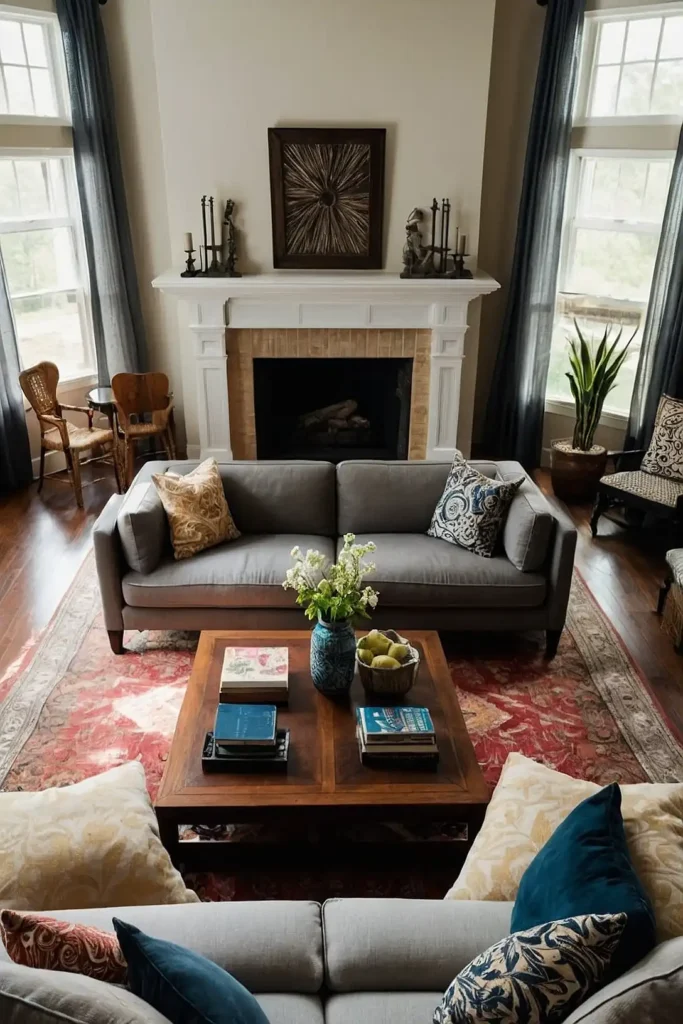
Position matching furniture pieces on either side of your room’s central focal point for classic elegance.
You’ll achieve formal balance that works beautifully in traditional and contemporary spaces.
Use identical side tables, lamps, or accent chairs to create visual harmony.
This mirrored approach provides sophisticated organization while maintaining practical functionality throughout.
Add asymmetrical elements through artwork or accessories to prevent rigidity.
The balanced foundation allows for creative expression while maintaining overall design cohesion and visual appeal.
14: Angled Furniture Dynamic Flow

Position your sofa and chairs at slight angles to create more interesting sight lines throughout your space.
You’ll improve conversation flow while adding visual movement to static arrangements.
Avoid placing all furniture parallel to walls for a more relaxed atmosphere.
The angled approach makes rooms feel less formal while maintaining practical functionality.
Use area rugs to anchor angled furniture groupings and define separate spaces.
This technique works especially well in large rooms that benefit from dynamic visual interest.
15: Reading Nook Corner Retreat
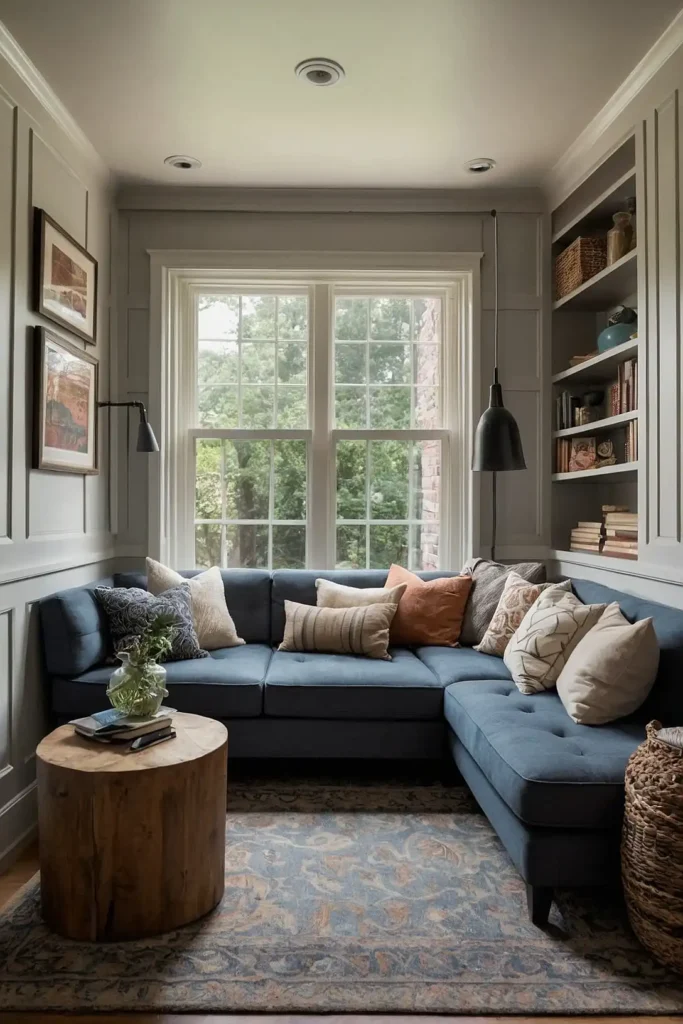
Designate a quiet corner with a comfortable chair, good lighting, and small side table for reading. You’ll create a personal sanctuary within your larger living space.
Add a floor lamp with adjustable light for optimal reading conditions.
This dedicated area provides escape while remaining connected to family activities and conversations.
Include a small bookshelf or basket for storing current reading materials conveniently. The specialized zone works perfectly in both small and large living room layouts.
16: Entertainment Zone Separation
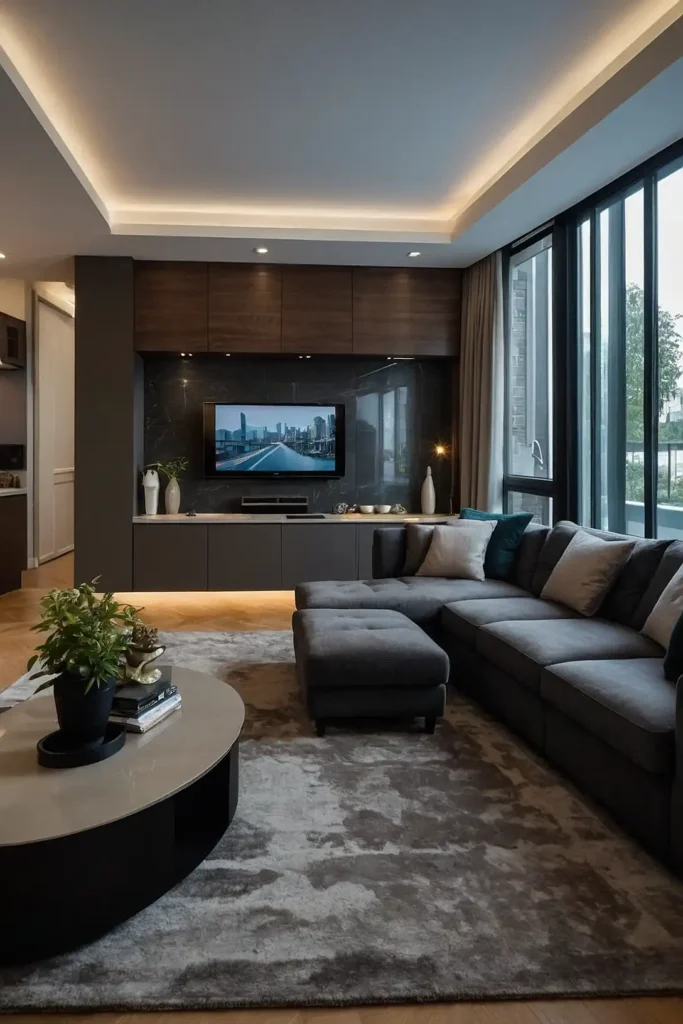
Create a dedicated media area that doesn’t dominate your entire living space through strategic furniture placement.
You’ll balance entertainment needs with conversation requirements perfectly.
Position seating to accommodate both TV viewing and face-to-face conversations comfortably.
This flexible arrangement adapts to different activities throughout the day and evening.
Add swivel chairs that rotate between entertainment and conversation positions easily.
The adaptable approach maximizes functionality while maintaining sophisticated design appeal throughout your room.
17: Open Traffic Lane Planning

Maintain clear pathways between all furniture pieces to ensure smooth movement throughout your space.
You’ll prevent bottlenecks while creating natural flow patterns for daily activities.
Leave at least 30 inches between major furniture pieces for comfortable navigation.
This spacing works for both small apartments and large open-concept living areas.
Position furniture to direct traffic around rather than through conversation areas.
The thoughtful placement protects intimate seating while maintaining accessibility to all room areas.
18: Natural Light Window Focus
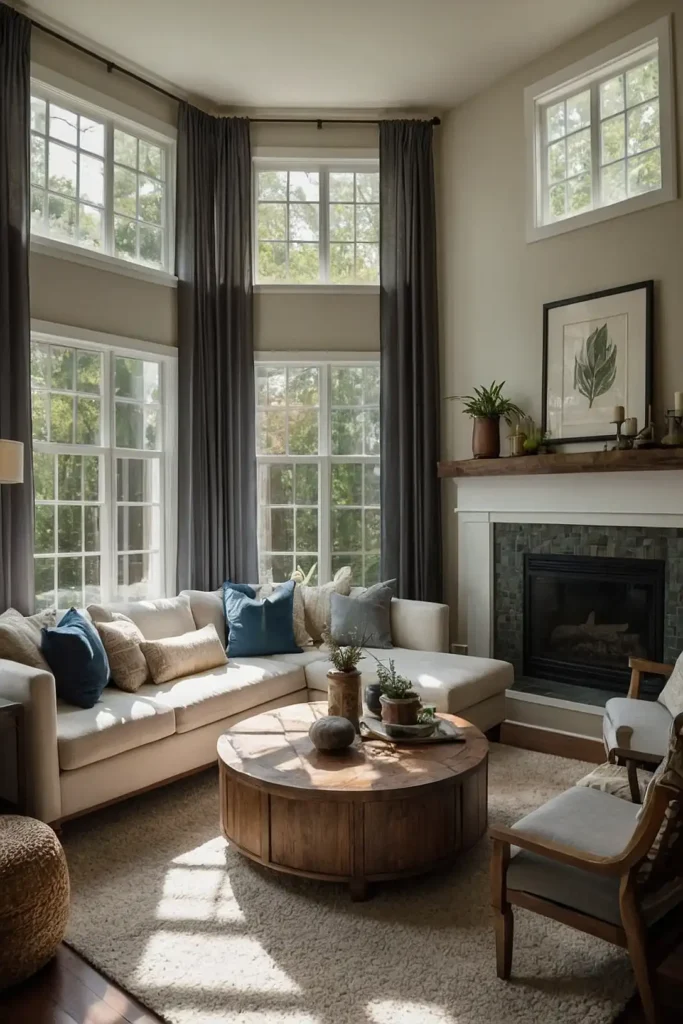
Arrange seating to take advantage of beautiful window views while avoiding glare issues.
You’ll connect indoor and outdoor spaces while maximizing daylight throughout your room.
Position chairs perpendicular to windows rather than directly facing them for comfortable conversations.
This approach prevents squinting while maintaining connection to outdoor views and natural lighting.
Add sheer window treatments that filter harsh light while preserving views.
The balance between privacy and openness creates comfortable conditions for all daily activities.
19: Flexible Modular Seating Systems
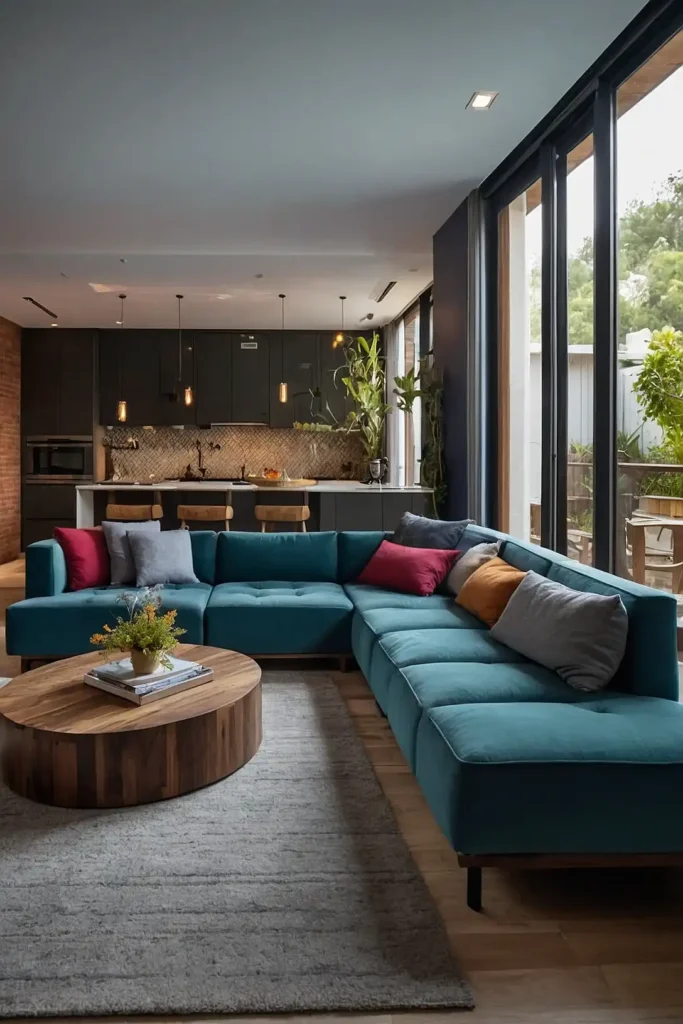
Choose furniture pieces that rearrange easily for different occasions and group sizes throughout the year.
You’ll adapt your space to hosting parties or intimate family gatherings.
Select lightweight chairs and ottomans that move effortlessly when needed.
This adaptable approach accommodates changing needs while maintaining everyday comfort and style preferences.
Create a basic arrangement that works for daily use with expansion options.
The flexible system grows with your lifestyle while maintaining visual cohesion throughout your space.
20: Area Rug Space Definition

Use appropriately sized rugs to visually connect furniture groupings while defining separate functional areas.
You’ll organize open spaces without installing permanent architectural elements or barriers.
Choose rugs large enough for front furniture legs to rest on comfortably.
This sizing creates cohesive groupings while anchoring pieces within the larger room layout effectively.
Select patterns and colors that complement your overall design scheme perfectly.
The coordinated approach ensures rugs enhance rather than compete with your existing furniture and decorative elements.
21: Scale Proportion Furniture Selection

Choose furniture sizes that complement your room’s dimensions for balanced visual appeal throughout the space.
You’ll avoid overwhelming small rooms or under-furnishing large areas.
Mix different furniture heights to create visual interest without sacrificing functionality.
This varied approach prevents monotonous arrangements while maintaining practical seating and storage solutions.
Measure your space carefully before purchasing to ensure proper fit and flow.
The proportional approach creates sophisticated arrangements that feel custom-designed for your specific room dimensions.
22: Gallery Wall Backdrop Creation
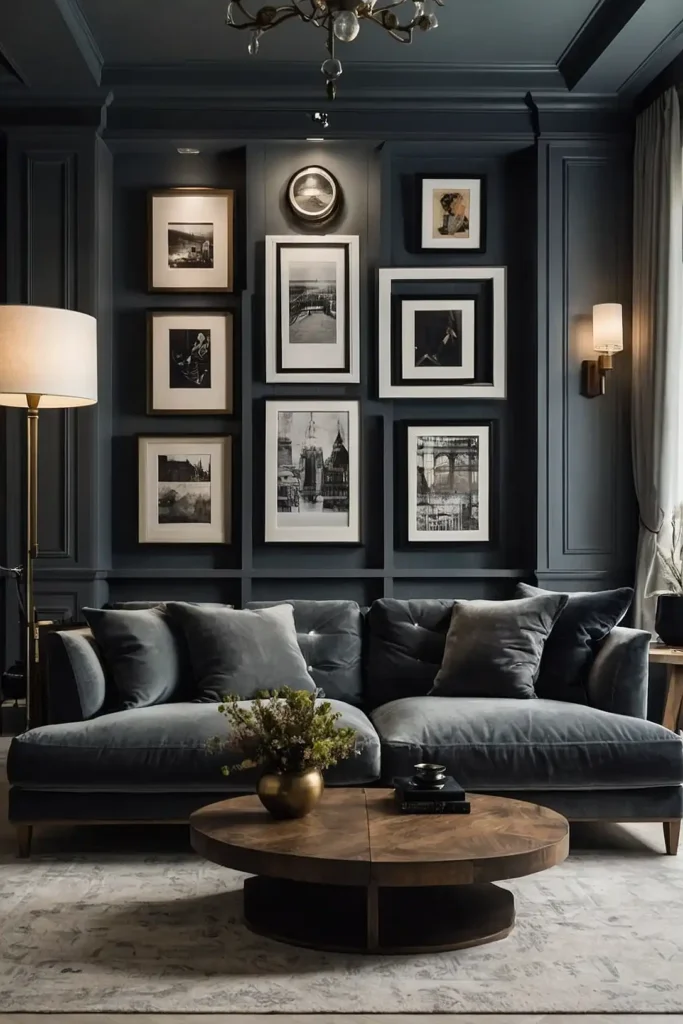
Design a cohesive art display that serves as a stunning backdrop for your seating arrangement.
You’ll add personality while creating visual interest behind your main furniture grouping.
Choose artwork sizes and frames that complement your sofa’s scale and proportions.
This coordinated approach ensures the gallery wall enhances rather than competes with your furniture pieces.
Mix different art mediums and sizes for dynamic visual appeal throughout the display.
The curated collection becomes a focal point that reflects your personal style and interests.
23: Minimalist Zen Space Approach
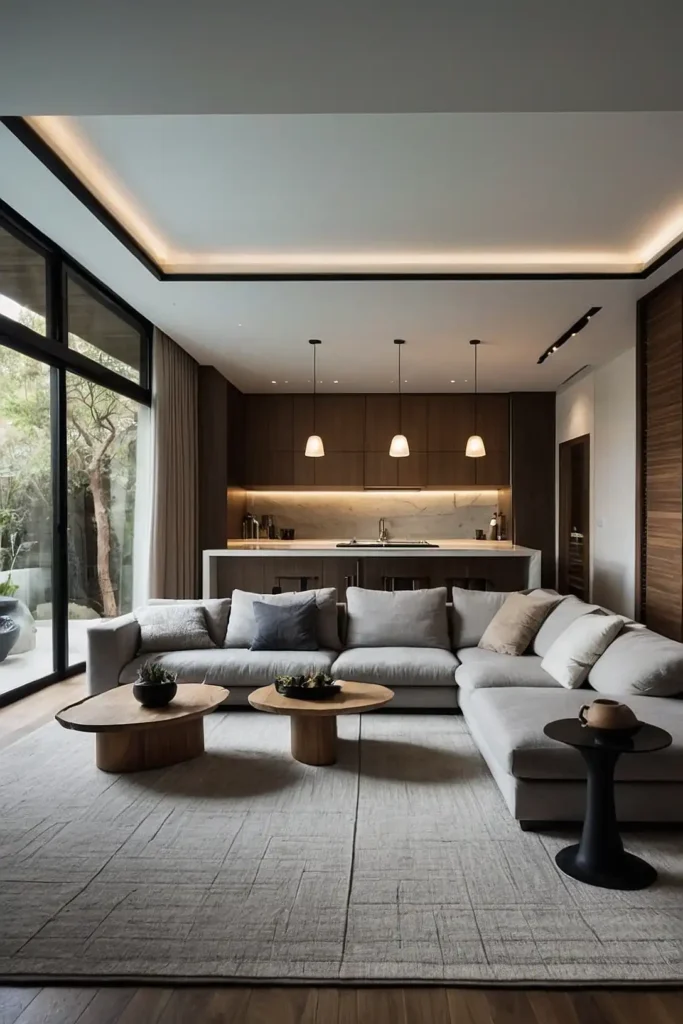
Embrace negative space by choosing fewer, high-quality furniture pieces that serve multiple functions efficiently.
You’ll create calm, uncluttered environments that promote relaxation and mindfulness.
Select neutral colors and clean lines that contribute to peaceful atmospheres.
This simplified approach reduces visual noise while maintaining all necessary functionality for daily living.
Add natural elements like plants or wood textures for warmth without clutter.
The organic touches soften minimalist edges while connecting your indoor space to nature’s calming influence.
24: Diagonal Pathway Flow Design
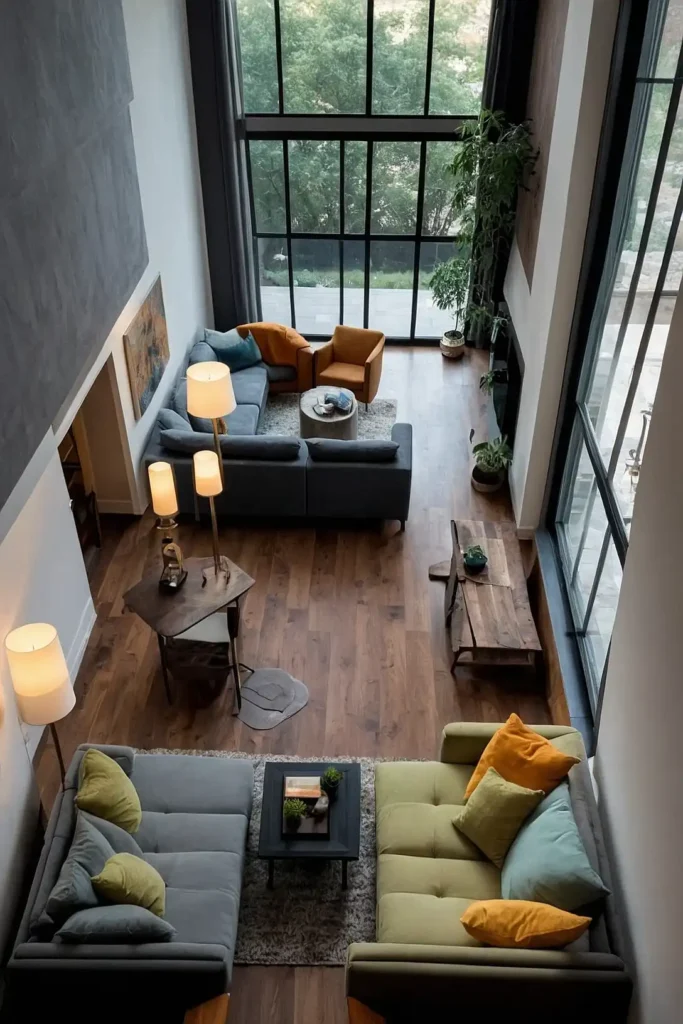
Position furniture at diagonal angles to create interesting movement patterns throughout your living space.
You’ll add visual dynamism while improving traffic flow and conversation opportunities significantly.
Use diagonal placement to make rectangular rooms feel less boxy and formal.
This approach breaks up predictable layouts while maintaining practical functionality for everyday use and entertaining.
Add accent pieces that follow the diagonal theme for design consistency.
The coordinated angles create sophisticated arrangements that feel intentionally designed rather than accidentally placed.
25: Layered Lighting Atmosphere Control
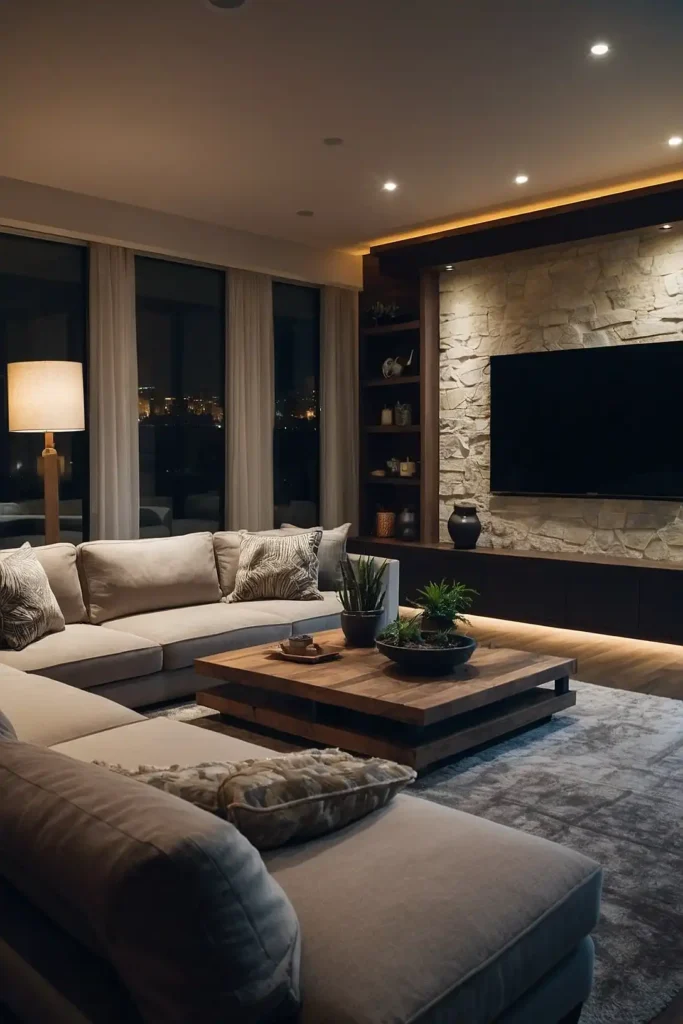
Combine overhead, task, and ambient lighting sources to create flexible illumination throughout your space.
You’ll establish different moods for various activities while maintaining practical visibility.
Position table lamps, floor lamps, and accent lighting at different heights for visual interest.
This layered approach eliminates harsh shadows while providing adequate light for reading and conversation.
Install dimmer switches to adjust lighting intensity based on time and activity.
The controllable illumination adapts your space from bright daytime functionality to cozy evening relaxation.
26: Curved Furniture Flow Enhancement
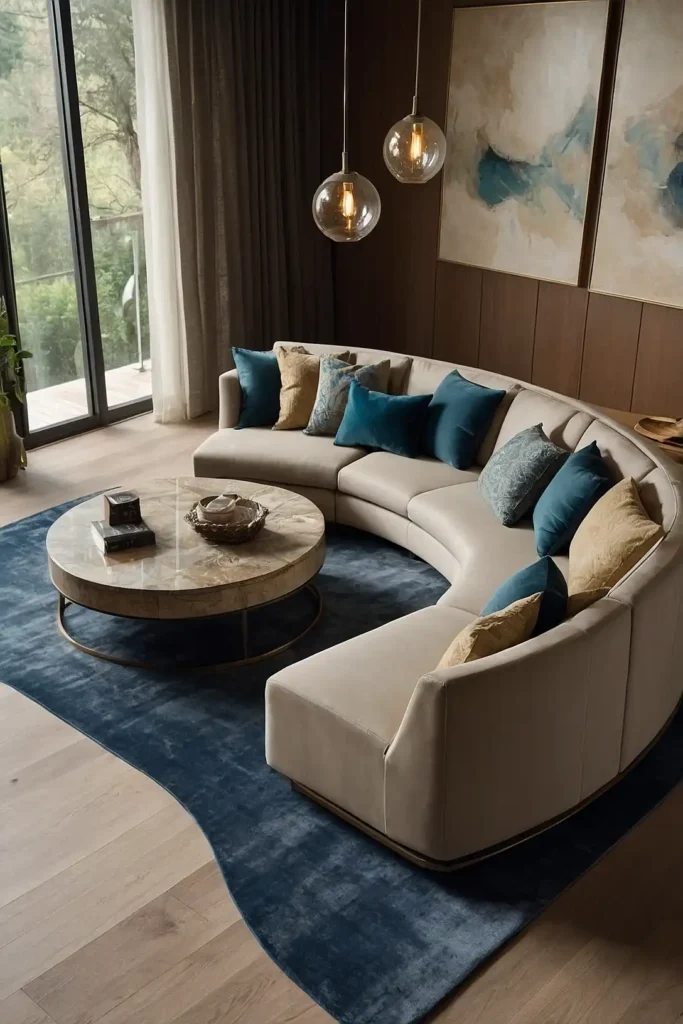
Incorporate round or curved furniture pieces to soften angular room layouts and improve traffic movement.
You’ll create gentler transitions while adding visual interest to rectangular spaces.
Choose curved sofas, round coffee tables, or circular accent chairs strategically.
These organic shapes balance linear architecture while providing comfortable seating and practical surface areas.
Position curved pieces to guide traffic flow naturally around conversation areas.
The smooth lines encourage movement while protecting intimate seating from interruption during gatherings and daily activities.
27: Seasonal Layout Flexibility Planning
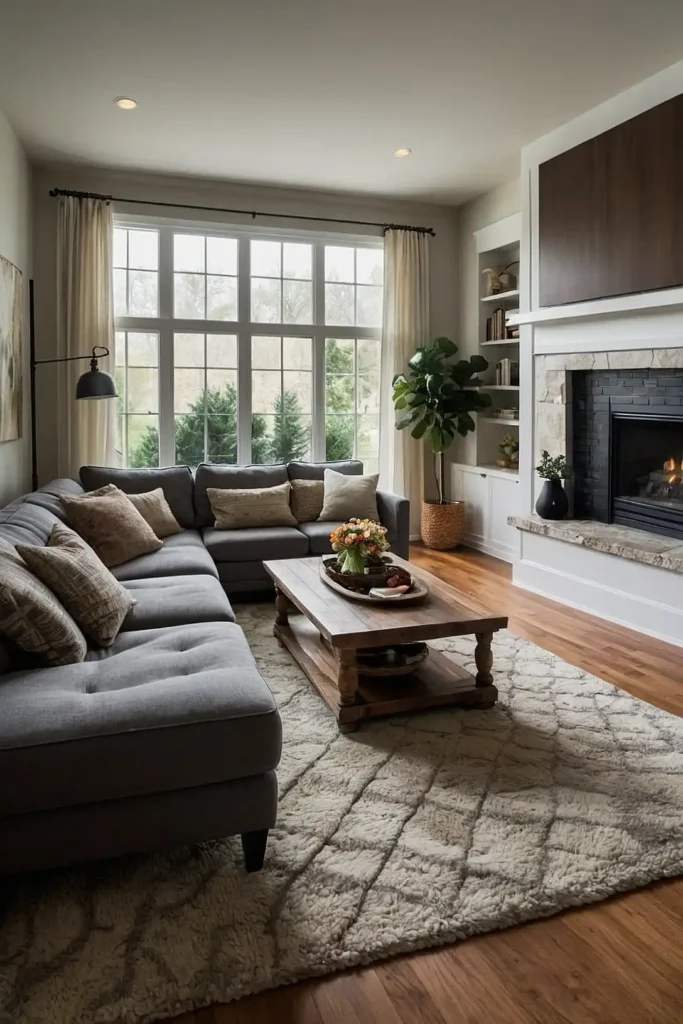
Design arrangements that adapt easily to different seasons and holiday celebrations throughout the year.
You’ll maintain fresh appeal while accommodating changing functional needs and decorative preferences.
Create a core layout that works year-round with seasonal accent additions.
This approach provides stability while allowing for creative expression through changing pillows, throws, and decorative accessories.
Plan storage solutions for seasonal items that don’t disrupt your basic arrangement.
The organized approach keeps your living room functional while enabling easy transitions between different seasonal looks.
Conclusion
These layout strategies transform any living room into a functional, beautiful space that reflects your lifestyle perfectly.
Smart arrangements make every room feel welcoming and well-designed.


